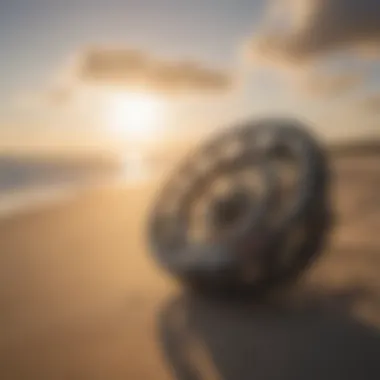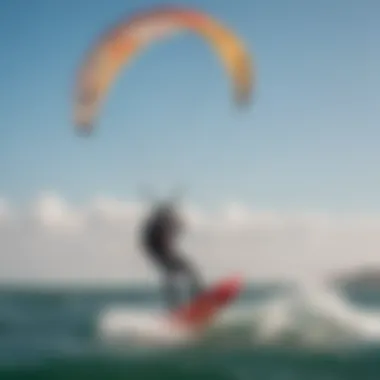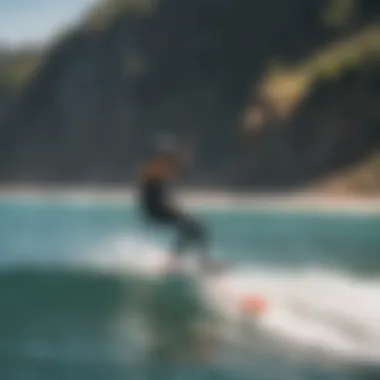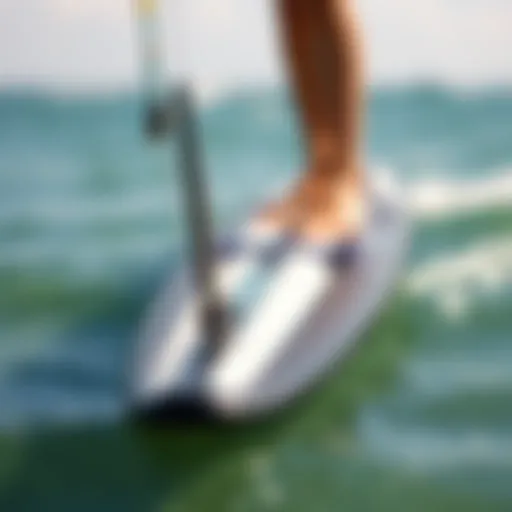Core Kiteboarding: Master Techniques and Insights


Intro
Kiteboarding is more than just a sport; it’s a fusion of skill, precision, and an appreciation for nature. Whether you’re gliding over water or soaring through the air, understanding the core elements of this thrilling activity is paramount. In this guide, we're diving into the fundamentals of gear, techniques, and safety practices, alongside more advanced tricks that experienced kiteboarders need to master.
The kiteboarding community thrives on camaraderie, education, and shared experiences. It's essential to engage, learn, and exchange insights with fellow enthusiasts, whether at the beach or online. This article will equip you with the knowledge needed to elevate your skills and truly savor every moment on the water.
Gear Insights
An essential element of kiteboarding is the gear; the right equipment can make or break your experience. As the sport evolves, so does the technology behind kiteboarding gear.
Latest Gear Reviews
When it comes to gear, keeping up with recent developments is crucial. Current trends showcase innovations aimed at maximizing performance and ensuring safety. For example, brands like North Kiteboarding and Cabrinha are noted for their cutting-edge kites, which focus on stability and responsiveness.
- North Orbit: Ideal for waves, it offers excellent lift and control.
- Cabrinha Contra: A favorite for beginners, known for its user-friendly design.
- Slingshot Rally: Provides versatility, making it suitable for all skill levels.
Regularly checking websites like Reddit or Facebook groups can provide valuable first-hand experiences and reviews from fellow kiters.
Essential Gear for Beginners
For newcomers, starting with the right gear simplifies the learning process. The essentials might include:
- A reliable kite appropriate for your skill level.
- A comfortable harness that fits well.
- A suitable board that matches the kite size.
- Safety equipment, including a helmet and impact vest.
Choosing gear that's both functional and comfortable can boost confidence and enhance your learning curve significantly. Investing time in understanding each component’s role is vital to excel in kiteboarding.
Techniques and Tips
Diving deeper into kiteboarding, the focus shifts to mastering techniques. Technique is the backbone of your success in this sport, and knowing advanced tricks can also add excitement to your sessions.
Advanced Tricks and Techniques
Once you’ve grasped the fundamentals, advancing to tricks can be exhilarating. Some sought-after maneuvers include:
- Kiteloops: A thrilling move that involves looping the kite while jumping.
- Board Off: Removing your board mid-air; an eye-catching feat.
- Backrolls: A smooth rotation in the air that showcases style.
Practicing in safe conditions, like flat water with experienced buddies, greatly reduces risk while honing these skills.
Safety Practices for Kiteboarders
Safety should never take a backseat. The unpredictability of wind and waves makes it crucial to adopt rigorous safety practices:
- Always check the weather conditions before riding.
- Wear a leash and other safety gear.
- Ensure your kite and lines are in good condition.
"Safety is not just a priority; it’s a necessity in kiteboarding. Always be prepared for the unexpected."
Regular safety drills and constant awareness of your surroundings can ensure not only your safety but that of others around you as well.
Mastering kiteboarding is a journey, full of learning and camaraderie. By sharpening your techniques, understanding your gear, and prioritizing safety, you embrace the essence of kiteboarding fully. Remember, it’s not just about riding the waves; it’s about fostering a deep respect for the sport and valuing every ride.
Preamble to Core Kiteboarding
Kiteboarding, with its exhilarating blend of wind, water, and skill, demands an understanding that goes beyond just catching a wave or flying high. Delving into the essence of kiteboarding, we come to realize the many layers involved—historical context, scientific principles, equipment needs, and necessary techniques. Each of these elements lays the groundwork for a deeper mastery, ensuring practitioners not only enjoy the sport but also engage with it meaningfully.
When one thinks about kiteboarding, it's easy to visualize the vibrant kites soaring against an azure sky, gliding gracefully over surf or shimmering waters. However, beneath this captivating sight lies the nuanced expertise that can profoundly affect a kiteboarder's performance. Having a firm grasp of the fundamentals is paramount; it helps in setting expectations, developing skills, and enhancing safety measures.
Benefits of Understanding Core Concepts
- Enhanced Skill Development: Knowing the historical evolution of the sport and the underlying physics gives kiteboarders a framework to build their abilities.
- Informed Equipment Choices: Understanding various types of kites and boards helps in selecting the right gear tailored to individual needs—keeping performance optimal and safe.
- Safety Awareness: Knowledge about the nuances of kite mechanics and environmental factors can aid in recognizing hazards and making informed decisions on the water.
As we journey through the varied aspects of kiteboarding, it's crucial to keep in mind that becoming adept at this sport is a continual process. From choosing the right gear to mastering complex maneuvers, the adventure spans more than just the thrill of riding. Let's begin by navigating the rich tapestry that constitutes the history of kiteboarding.
Historical Overview of Kiteboarding
The threads of kiteboarding history are woven with rich tales of innovation and adaptation. Although the concept of using a kite for propulsion dates back centuries to early Chinese and Polynesian cultures, the modern sport saw the light in the late 20th century.
In the 1970s and 1980s, pioneers began to experiment with kitesurfing—a sport that combined surfing, windsurfing, and traditional kiting. The first commercially available kitesurfing equipment emerged in the early 1990s, echoing the ingenuity of inventors like the Frenchman, Bruno Legaignoux, who designed the first inflatable kite.
By the 2000s, kiteboarding gained significant traction worldwide, aligning with a burgeoning interest in extreme sports. Events like the Kiteboarding World Cup put the sport on the global stage, drawing in enthusiasts from various walks of life. Today, we view kiteboarding not just as a pastime but as a dynamic, evolving discipline that captivates those willing to embrace the thrills and challenges of riding on wind and waves.


Understanding the Physics Behind Kiteboarding
At first glance, the dance of kiteboarding may seem purely aesthetic, governed by instinct and bravado. Yet, to master this exhilarating sport, one must delve into the physical principles that govern it—namely, aerodynamics, lift, drag, and the behavior of water.
Kites work based on the principles of lift. When the kite is maneuvered through the wind, it generates upward force due to differences in air pressure on either side of its surface. The angle at which the kite is held to the wind—not too steep or too shallow—can greatly influence how efficiently it catches the breeze.
Additionally, understanding drag is crucial for controlling speed and direction.
With more experience, kiteboarders learn how to adjust their body positioning and manipulate their kite to respond to varying wind conditions. These are essential skills that allow one to ride seamlessly, avoid crashes, and even execute advanced tricks.
"Physics may seem daunting, but in kiteboarding, it becomes a powerful ally enabling you to harness the sea and sky."
By blending the thrill of maneuvers with the intelligent application of these principles, kiteboarders elevate their experience from mere enjoyment to masterful execution. Through each jump and turn, the balance of physics plays out—a fascinating symphony of art and science.
Essential Gear for Kiteboarding
Kiteboarding is a sport that relies heavily on the right gear. It’s not just about looking cool on the water; having the appropriate equipment can mean the difference between a thrilling ride and a disastrous mishap. Each piece of gear plays a pivotal role in enhancing your kiting experience, ensuring both performance and safety. As you delve into the waves and air, understanding the equipment you utilize is crucial for mastering the art of kiteboarding. Let's break down the integral components, starting with kites.
Types of Kites: A Comprehensive Guide
When it comes to kiteboarding, the kite is the heart of the operation. The choice of kite affects everything from speed to maneuverability. Broadly, kites can be classified into three types: C kites, Bow kites, and Delta kites.
- C Kites: Known for their powerful pull and responsiveness, C kites are favored by freestyle riders. Their shape allows for higher jumps and better aerial performance. However, they may not be the best choice for beginners since they can be tricky to control if you’re just starting out.
- Bow Kites: These kites are more forgiving and user-friendly. Their design offers a flatter shape which increases lift, making them ideal for those who are new to the sport. They also generate a significant amount of power at low speeds, allowing for easier water starts.
- Delta Kites: Combining features from both C and Bow kites, Delta kites provide an excellent balance between performance and stability. They work well in a variety of wind conditions and are suitable for intermediate to advanced riders.
Understanding the differences in kite types can facilitate informed purchasing decisions, aligning gear with individual skill level and riding styles.
Boards: Finding the Right Fit
Picking the right board is just as critical as selecting the kite. The board you choose impacts your speed, control, and comfort on the water. Kiteboards generally fall into two categories: ** directional boards** and twin-tip boards.
- Directional Boards: These boards are great for those focused on surf-style riding. They’re designed to ride with the wind, which can be a delightful experience on waves. However, they demand a bit more skill to maneuver.
- Twin-Tip Boards: These boards are the go-to for most kiteboarders, especially beginners. They are symmetrical, allowing riders to switch directions easily. This adaptability makes learning new tricks much simpler.
Additionally, board size matters. A larger board offers more stability and is better for beginners, as it provides a larger surface area that helps with starting on the water and catches the wind better. In contrast, a smaller board offers more control and speed for experienced riders who are mastering advanced techniques.
Safety Equipment: Prioritizing Protection
Safety can't take a back seat in kiteboarding. Having the right safety equipment is essential for minimizing risks. Key items to consider include:
- Harness: Wearing a proper harness is crucial as it distributes the force from the line to your body, allowing for more comfortable rides. There are waist and seat harnesses—choose one based on your preference for freedom of movement or support.
- Helmet: Protecting your head should be a top priority. A well-fitted helmet will guard against sudden impacts, especially after a wipeout.
- Impact Vest: While not a replacement for a life jacket, an impact vest offers additional protection against falls and can help with buoyancy to some extent.
- Life Jacket: Although it may not be required in all locations, wearing a life jacket can provide crucial buoyancy in case of emergency. It’s particularly important for those venturing into unfamiliar waters.
In short, investing in proper safety gear isn’t just smart; it’s essential. As the saying goes, "Better safe than sorry!" The right equipment can make your time on the water much more enjoyable, allowing you to focus on honing your skills without unnecessary worries.
"A chain is only as strong as its weakest link." In kiteboarding, that weak link could be your gear. Don’t compromise on quality!
Understanding and investing in your gear not only enhances your performance but also ensures that you are well-protected as you navigate the wind and water. As kiteboarding continues to evolve, the right choices in gear can help you stay ahead of the curve.
Techniques in Kiteboarding
Understanding the diverse techniques in kiteboarding is fundamental for every rider, whether you're just starting out or you're looking to refine your skills. Mastery in kiteboarding isn't simply about catching the wind in your sails; it revolves around understanding how to harness that power effectively and safely. Having a solid grasp on different techniques not only enhances your control but can also significantly improve your performance, making your sessions more enjoyable and less frustrating.
Fundamental Skills for Beginners
When embarking on the adventure of kiteboarding, foundational skills are crucial. These areas help to foster confidence in the water and pave the way for more advanced techniques later. Here are some primary skills every beginner should focus on:
- Body Dragging: This involves using the kite to pull your body through the water without a board. It's essential for learning how to control the kite and get accustomed to the sensation of being pulled through waves.
- Water Starts: Mastering the water start is a game-changer. This skill is all about combining your kite control with accurately placing your feet on the board. Focus on finding that sweet spot where you can lift off smoothly and ride.
- Relaunching the Kite: It’s key to know how to relaunch your kite from the water safely. Different techniques can be employed depending on the wind condition and kite type, but knowledgeable relaunching helps prevent frustration during a session.
These basic skills lay the groundwork for a successful kiteboarding experience. Practicing them often will build your confidence and prepare you for more complex maneuvers down the road.
Intermediate Techniques to Enhance Control
Once you’ve got the fundamentals down, it’s time to elevate your kiteboarding prowess. Intermediate techniques can significantly enhance your control over the kite and board. Here’s what to focus on:
- Edge Control: This is about learning how to use the edge of your board to manage speed and direction. Proper edging lets you carve through the water more efficiently, making for smoother rides.
- Gust Management: Gusty winds can be tricky. Finding the balance between depowering the kite and maintaining control during sudden gusts is critical. It’s all about reading the wind and knowing how to respond.
- Jumping Basics: The thrill of kiteboarding often lies in the air. Learning to jump involves understanding the timing of the kite's pull as you release off the water. Start with small hops and build up to bigger jumps as your confidence grows.
Grasping these intermediate skills means more than just keeping up with fellow riders; it opens doors to new experiences and styles of riding, enriching your overall kiteboarding journey.
Advanced Maneuvers for Expert Kiteboarders
For those seasoned in the world of kiteboarding, advanced techniques provide opportunities for expression and creativity. These maneuvers can elevate your riding to an art form:
- Handle Passes: This is an eye-catching maneuver where the rider passes the control bar behind their back while in the air. It requires a combination of timing, strength, and practice to nail down.
- Kiteloops: A thrilling move that involves looping the kite while in the air. It takes a fair bit of courage and finesse but can lead to impressive air time and tricks.
- Freestyle Tricks: Once comfortable with tricks, adding spins, grabs, and flips to your repertoire can truly showcase your skills. Whether you’re into wakestyle or more fluid movements, freestyle riding allows for reflection of personal style.


These techniques will not only improve your riding skills but also allow you to showcase your style and creativity on the water.
"Kiteboarding is not just about the physical skills; it’s an art form that requires understanding, flow, and creativity."
With each level of skill you acquire, you will find the thrill of kiteboarding evolving into a deeper relationship with the sport. The journey from a novice to an expert is marked by practice, curiosity, and the will to push your limits.
Safety Practices in Kiteboarding
Safety practices in kiteboarding are as essential as the wind that fills your kite. These practices not only protect the kiteboarder but also contribute to a smoother experience on the water. Engaging in kiteboarding can be thrilling, but it can also be unforgiving if proper safety protocols are ignored. This section will address three pivotal areas: pre-ride safety checks, recognizing and avoiding hazards, and post-ride evaluations. Each element plays a critical role in ensuring not only your safety but also fostering a culture of responsibility within the kiteboarding community.
Pre-Ride Safety Checks
Before even thinking about hitting the waves, it's crucial to conduct thorough pre-ride safety checks. Familiarize yourself with your equipment and the prevailing conditions. Here’s a checklist to guide you:
- Kite Inspection: Always check your kite for any tears, leaks, or signs of wear. Ensure that all lines are untangled and free of knots.
- Safety Systems: Test your safety release mechanism. This small action can save your life in critical situations. If your kite does not respond correctly during a test, refrain from riding.
- Harness and Leash: Check that your harness fits snugly and that the leash is securely attached. A loose harness can lead to control issues.
- Weather Conditions: Review current weather forecasts. Wind speed and direction should be suitable for your skill level and equipment.
Taking these pre-ride checks seriously can help avoid mishaps once you're out on the water. It’s often said, “An ounce of prevention is worth a pound of cure.” This holds true in kiteboarding more than anything else.
Recognizing and Avoiding Hazards
When kiteboarding, being aware of your surroundings is as vital as controlling your kite. Hazards can pop up like weeds in a garden, from unexpected weather changes to obstacles on the water. Here are some common hazards and ways to avoid them:
- Obstacles: Watch for boats, jet skis, swimmers, and other kiteboarders. Collisions can lead to serious injuries or damage.
- Strong Currents: Be cautious of strong tides or rip currents. Being swept away can quickly escalate into a dangerous situation.
- Variable Wind: Wind conditions can shift suddenly. A calm surface can turn into a tumultuous experience if the wind speeds up unexpectedly.
- Environmental Considerations: Respect the local habitat. This includes avoiding areas that might disturb wildlife or protected zones.
Staying vigilant and adapting to the environment can be the difference between a remarkable session and a ruinous ordeal. As they say in the field, “When in doubt, don’t go out.”
Post-Ride Evaluations: Lessons Learned
After the thrill of kiteboarding, reflecting on your experience adds to your growth as a kiteboarder. A post-ride evaluation helps identify what went well and what needs improvement. Here’s how you can make it effective:
- Gear Check: Post-ride inspections ensure that any issues are noted before your next outing. Look for any damages or wear on your kite, board, and safety gear.
- Self-Reflection: Consider your performance. Was there a moment where you felt unsure? Analyzing your ride can reveal areas to focus on for next time.
- Seek Feedback: If you’re with others, don’t hesitate to ask for input. Peer insights can be invaluable in spotting things you might miss on your own.
- Log Your Progress: Keep a log of your rides. Note conditions, gear used, and feelings post-ride. This establishes a reference for future sessions and marks your improvement over time.
The great thing about kiteboarding is that even after riding, the learning never stops. At the end of the day, turning lessons into building blocks for your next adventure is what keeps the spirit alive in this sport. As one seasoned kiteboarder accurately put it, "Every ride is a teacher in disguise."
Travel Insights for Kiteboarding
Traveling for kiteboarding can be a game-changer, bringing fresh experiences, varied conditions, and rich cultural narratives that can significantly enhance your skills and understanding of the sport. There's something uniquely exhilarating about exploring new locations with your kite gear in tow. The wind, the waves, and the local spirit all combine to create a session unlike any other. Proper travel insights become invaluable as they guide kiteboarders through this adventure, ensuring not only a successful trip but also a memorable one.
Identifying Prime Kiteboarding Locations
When it comes to kiteboarding, the location plays a key role in your overall experience. There are certain spots around the globe that every kiteboarder dreams of tackling. Places like Tarifa in Spain, known for its almost constant winds, and the pristine beaches of Cape Town offer a mix of challenging and enjoyable conditions.
Consider the following points when choosing a kiteboarding location:
- Wind Conditions: Sites with reliable wind patterns are essential. Locations like the Baja Peninsula in Mexico are famous for their consistent breezes during certain seasons.
- Water Conditions: Look for places that offer ideal water conditions, whether it’s waves, flat water, or a mix of both. Spots like Hood River in Oregon cater to a variety of skill levels with their diverse environments.
- Accessibility: It’s imprtant to consider how easy it is to get to a location, both in terms of transportation and local facilities such as rentals and schools.
These factors not only affect the quality of your kiteboarding experience but also your safety and enjoyment. Each region offers its unique flair, with local spots often holding hidden gems just waiting to be discovered.
Cultural Considerations for Global Travel
Every kiteboarding hotspot has its own culture, which can greatly enhance or affect your experience. Understanding these local customs and traditions can make your travels more enriching.
When visiting a new region for kiteboarding, keep these cultural insights in mind:
- Local Etiquette: Each location may have its own set of rules and customs regarding kiteboarding behavior. For instance, some areas might prioritize right-of-way rules that differ from your home spots.
- Environmental Responsibility: Many places employ conservation efforts to protect their ecosystems. Participate in local initiatives, for instance, beach clean-ups after a long day of boarding. Not only does this help maintain the beauty of the location, but it positively reflects on the kiteboarding community.
- Language Barriers: While English is widely spoken in tourist areas, learning a few basic phrases in the local language can go a long way. A friendly greeting in the native tongue can help break the ice with locals, enhancing your experience.
Packing Essentials for the Kiteboarder
Packing wisely can save a lot of hassle and ensure you have everything you need for a fantastic kiteboarding trip. Below are the essentials to consider before you jet off:
- Kite and Board: Naturally, your gear is paramount. Ensure you have the right size for prevailing conditions at your destination.
- Safety Equipment: Don’t skimp on safety gear. Your harness, life jacket, and helmet should always be included in your packing list. They are critical for both safety and compliance with local laws.
- Clothing: Depending on the region, bring a mix of wetsuits or light attire and ensure you have proper sun protection. Rash guards and hats can help keep you safe from the elements.
- Repair Kit: Accidents happen, so include a repair kit for quick fixes on the go. This should have essentials like spare lines, patch material, and tools.
- Travel Documents: Always keep your ID, insurance details, and any required permits handy. In places with rigorous regulations, showing that you’re informed can save a lot of stress.
By understanding where to go, respecting local cultures, and packing adequately, kiteboarding travelers can maximize their experience, ensuring it’s not just memorable but also transformative.
"Travel not to escape life, but so life does not escape you."
This encapsulates the essence of combining the adventure of kiteboarding with the thrill of exploration.
Community and Education in Kiteboarding


The world of kiteboarding extends beyond the thrill of riding the wind and waves. It's a vibrant community bolstered by shared experiences and mutual learning. This section delves into the significance of community and education in kiteboarding, underscoring how fostering these elements can dramatically enhance the skillset, safety, and overall enjoyment of the sport.
The Role of Clubs and Associations
Kiteboarding clubs and associations play a pivotal role in shaping the landscape of the sport. These organizations serve as gathering spots for enthusiasts, where members can engage in discussions, share experiences, and partake in events that build camaraderie. Clubs often host training sessions, competitions, and social gatherings, making them essential for those looking to expand their skills in a supportive environment.
Moreover, these clubs often collaborate with local authorities to ensure safe practices and access to prime kiteboarding locations. For instance, a club can help advocate for designated kiteboarding zones, keeping both the riders and other water users informed of safety guidelines. This collective strength allows kiteboarders to voice their needs effectively, making it easier to maintain harmonious relationships within the community.
Many clubs also offer structured lessons, led by experienced instructors who have a wealth of knowledge to share. These lessons provide a safe entry point for beginners and an opportunity for advanced riders to refine their techniques. So, being part of a club not only enhances one's skills but also builds lasting friendships.
Finding Mentors in the Kiteboarding Community
Mentorship can be a game-changer in kiteboarding. A good mentor helps you cut through the fluff and gets to the crux of what’s essential for improvement. Finding the right mentor in the kiteboarding community lays the groundwork for faster progress and deeper understanding of the sport.
The best mentors are usually those who have walked the path you're on. They can offer insights that no book or online resource might cover. For example, a seasoned kiteboarder who started during the sport's infancy will have firsthand knowledge of the evolution of techniques and equipment. Their advice can help avoid pitfalls and even inspire creativity in mastering maneuvers.
To find a mentor:
- Engage actively in clubs: Attend meetings and events regularly to meet potential mentors.
- Volunteer for events: Being involved in kiteboarding competitions as a helper can connect you with experienced riders.
- Ask for help: Never hesitate to reach out to practitioners you admire; most will be glad to assist.
Finding a mentor isn't merely a pragmatic approach to learning but often results in deep friendships, sparking a worthwhile exchange of wisdom.
Online Resources for Continued Learning
As the digital age rushes on, kiteboarders increasingly turn to online resources for tips, tricks, and tutorials. The internet is a treasure trove, offering accessible knowledge for all levels of riders.
Here are some valuable online platforms:
- YouTube: Watch instructional videos and tutorials from kiteboarding experts to grasp new techniques.
- Reddit’s Kiteboarding Subreddit: This community-driven space provides invaluable advice, highlight stories, and gear recommendations from diverse riders, enriching your understanding.
- Facebook Groups: Engaging with specific kiteboarding groups can enhance your learning via shared experiences and questions.
These resources often feature user-generated content, creating a platform for feedback and discussion. Participating in online forums offers the opportunity to connect globally while honing your craft. For those keen on continuous improvement, utilizing such platforms complements practical sessions on the water, ensuring a well-rounded journey in kiteboarding.
"Continual learning not only sharpens your skills but also connects you with like-minded individuals who share your passion for riding the waves."
In summary, the community and education components are crucial in navigating the kiteboarding realm. From engaging with clubs and mentors to diving into online resources, these facets of kiteboarding enrich the sport beyond just the ride—they build relationships, foster a sense of belonging, and ensure ongoing personal development.
Environmental Impact of Kiteboarding
Kiteboarding, while exhilarating and adventurous, also comes with environmental considerations. Awareness about how this thriving sport interacts with natural ecosystems is growing among enthusiasts diving into the waters and winds. Kiteboarding can have effects on coastal areas, marine life, and local communities. As kiteboarding continues to elevate in popularity, understanding its impact becomes essential for preserving the environments that make this sport possible.
Sustainable Practices for Kiteboarders
A significant way kiteboarders can contribute to environmental sustainability includes adopting responsible practices. Sustainable kiteboarding means minimizing the ecological footprint during every session on the water. Some effective sustainable practices include:
- Proper Gear Maintenance: Keeping kites and boards in good condition helps reduce waste. A well-maintained piece of equipment lasts longer, decreasing the need for replacements.
- Eco-Friendly Products: Opting for brands that prioritize sustainability in their manufacturing processes—like using recyclable materials—can contribute to lessening the environmental impact. For instance, checking out brands like Naish or Cabrinha that have launched eco-friendly lines.
- Leave No Trace Principles: Following these guidelines means cleaning up all gear, litter, or any waste after a session. Respect for the natural environment becomes a key part of the sport.
- Plan Your Trip Wisely: Carpooling or using public transport when heading to popular kiteboarding spots can help lower carbon emissions, making travels a bit greener.
These sustainable practices not only protect natural habitats but also elevate the consciousness among the kiteboarding community about their responsibility toward environmental stewardship.
Conservation Efforts and Community Involvement
Kiteboarders are often familiar with their surroundings. Many are emerging as passionate advocates for coastal conservation. Joining forces with local environmental groups creates synergies that benefit natural habitats. Here’s how community involvement can enhance conservation efforts:
- Education and Awareness Campaigns: Participating in or organizing community events that focus on educating others about the importance of conserving coastal ecosystems fosters a deeper connection with nature among kiteboarders.
- Volunteering for Clean-ups: Many local organizations arrange beach clean-ups aimed at removing debris and pollutants that harm wildlife. Engaging in these activities not only helps the environment but builds camaraderie within the kiteboarding community.
- Advocating for Marine Protected Areas: Kiteboarders can play a role in advocating for regions designated as protected areas, ensuring that these pristine environments remain intact for generations to come. This can be done through petitions or public engagement with local government.
- Social Media for Good: Platforms like Facebook, Reddit, or even specialized forums can serve as spaces to raise awareness, share resources, and inspire others to take action for environmental conservation.
"Being a responsible kiteboarder means understanding our role in protecting the environments we cherish. Our waterways are not just playgrounds; they’re vital ecosystems that require our care."
Contributions made towards conservation reflect a kiteboarder’s respect for the sport and the natural world intertwined with it. Ultimately, being part of the solution provides an enriching layer to the kiteboarding experience.
Ending: The Future of Kiteboarding
In the realm of kiteboarding, the horizon is constantly expanding, shaped by advancements in technology, shifting environmental considerations, and a growing community of enthusiasts. Understanding the future of kiteboarding not only highlights the evolution of this exhilarating sport but also underscores the importance of adapting to new trends and embracing change.
Emerging Trends and Technologies
As kiteboarding continues to mature, both seasoned racers and weekend warriors are witnessing a wave of innovations. One of the most notable trends is the integration of smart technology into kiteboarding gear. For instance, smart kites equipped with sensors now provide real-time feedback on performance, wind conditions, and even personal safety metrics. These technological enhancements can help you tune in to your performance, enabling a more personalized and refined experience on the water.
Another emerging trend is the rise of foil kiteboarding, which emphasizes efficiency and ease of use. This subset of kiteboarding utilizes a hydrofoil that lifts the board above the water, cutting down on drag and allowing for smoother rides, even in lighter winds. As more riders adopt this technique, we can expect to see an increase in specialized gear tailored for foil kiteboarding, making it more accessible to all skill levels.
"Embracing the new technology in kiteboarding revolutionizes not just the gear, but also the way we connect with the environment."
Anticipating the Growth of the Kiteboarding Community
The kiteboarding community is more than just a collection of riders - it's a global network of adventurers, innovators, and passionate advocates for the sport. As kiteboarding gains traction in different parts of the world, including emerging markets in Asia and Africa, opportunities for participation and collaboration are expanding rapidly. This growth not only enriches the experience for existing riders but also encourages newcomers to join the fray.
In recent years, grassroots organizations and clubs have sprouted up with the intention to educate and foster a safe, inclusive environment for all. These communities are essential for promoting values of respect, cooperation, and environmental stewardship. As kiteboarding clinics, workshops, and competitions become more common, participants will find numerous avenues to enhance their skills while forming lasting bonds with others who share their passion.
The future of kiteboarding thus invites us to be thoughtful stewards of the sport. By actively participating in community initiatives, contributing to sustainable practices, and supporting emerging athletes, we can shape the direction kiteboarding takes in the years ahead. The journey forward is as exciting as the ride itself, revealing endless possibilities for growth, learning, and connection.















